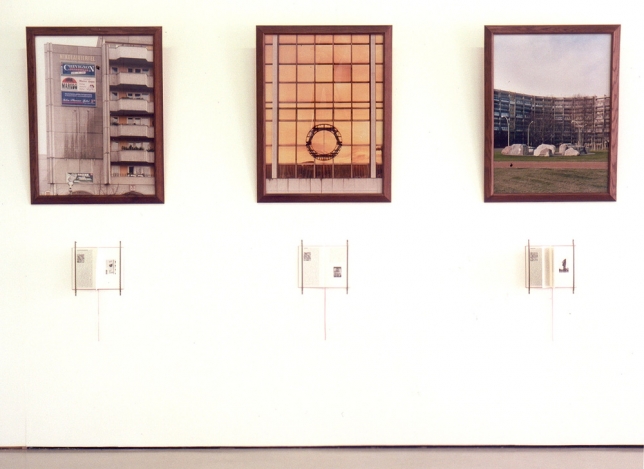26.10. - 08.12.1996
Sophie Calle: „The Detachment - Die Entfernung“
Solo exhibition at Arndt & Partner, Berlin
DIE ENTFERNUNG – THE DETACHMENT
To record this process, I visited places from which symbols of GDR history have been effaced. I asked passers-by and residents to describe the objects that once filled these empty spaces. I photographed their absence and replaced the missing monuments with their memories.« (Sophie Calle)
Succinctly and precisely, the artist describes the concept behind her installation »Die Entfernung – The Detachment«, in which she graphically demonstrates and documents how the reunited city of Berlin comes to terms with its own history, and at the same time raises basic questions about our own existence – for instance how and to what degree we can recall the past, and how memory and personal identity define each other. Such fundamental questions have defined Sophie Calle’s art since its beginnings in the early eighties. The initial focus of her work was her own sense of personal identity, for on returning to Paris after several years of living abroad, she had to rediscover her bearings in the now unfamiliar city of her youth. A candidly voyeuristic project helped to refamiliarise her with what had become an alien environment: camera and notebook in hand, Calle secretly followed a complete stranger through the city streets, construing from her observations everyday stories of Parisian life ambiguously located between fiction and reality. Such shifts between realistic documentation and fictitious constructs also characterise her later work. In »Venetian Suite« (1980), for instance, she pursues a fleeting acquaintance toVenice, observing his movements like a private detective;in »The Hotel« (1981) she gets a job as achambermaid in a Venetian hotel and rummagesthrough the guests’ suitcases, looking for clues tounfamiliar lives. In another project, »The Shadow«(1981), she has herself followed by a detective engagedby her own mother and afterwards comparesnotes with him – but only after having him shadowedin his turn by a friend of hers as he carries outhis assignment. These projects demonstrate how weattempt to shed light on our own lives by compulsivelycomparing them with other, unfamiliar biographies.Such confrontations with the way othersare – for instance with a Russian on the Trans-Siberian Express (»Anatoli«, 1984) – sharpen oursense of the way we ourselves are. Yet it is also clearthat any amount of information on other people’slives does not bring us closer to experiencing theirunique individuality. On the contrary, the moreinformation we collect and the closer we believe weare to the individual in question, the more shadowyand intangible the latter’s personality is rendered byour often contradictory observations and descriptions(»The Man with the Address Book«, 1983).instance, she pursues a fleeting acquaintance toVenice, observing his movements like a private detective;in »The Hotel« (1981) she gets a job as achambermaid in a Venetian hotel and rummagesthrough the guests’ suitcases, looking for clues tounfamiliar lives. In another project, »The Shadow«(1981), she has herself followed by a detective engagedby her own mother and afterwards comparesnotes with him – but only after having him shadowedin his turn by a friend of hers as he carries outhis assignment. These projects demonstrate how weattempt to shed light on our own lives by compulsivelycomparing them with other, unfamiliar biographies.Such confrontations with the way othersare – for instance with a Russian on the Trans-Siberian Express (»Anatoli«, 1984) – sharpen oursense of the way we ourselves are. Yet it is also clearthat any amount of information on other people’slives does not bring us closer to experiencing theirunique individuality. On the contrary, the moreinformation we collect and the closer we believe weare to the individual in question, the more shadowyand intangible the latter’s personality is rendered byour often contradictory observations and descriptions(»The Man with the Address Book«, 1983).This is also true of »Die Entfernung – The Detachment«. The passers-by’s recollections cannot fill out the empty space in the photograph where the monument once stood, or, for instance, where the GDR state emblem used to hang on the Palace of the Republic (see photograph above). Their recollections are in part so contradictory that the reader begins to doubt whether they are referring to one and the same monument – it has also been »detached« from people’s memories. At the same time, the highly emotional texts testify to the enduring presence in human consciousness of what has disappeared from their world. Sophie Calle’s installation opens our eyes to the complex way in which we perceive reality – and to the equally complex way in which history and the present are interwoven. In this respect, »Die Entfernung – The Detachment« is one of the most revealing artworks on the history of inter-German relations and its contemporary afterimage. Text: Andreas Kaernbach
